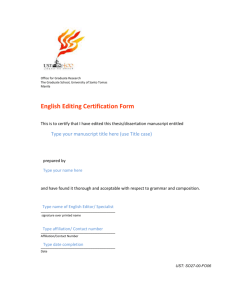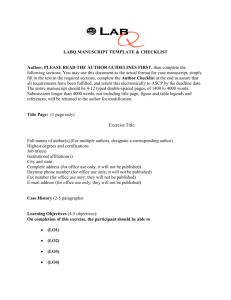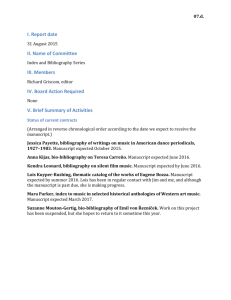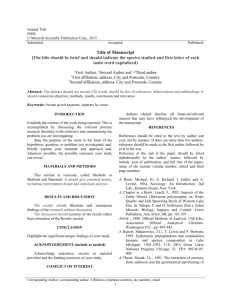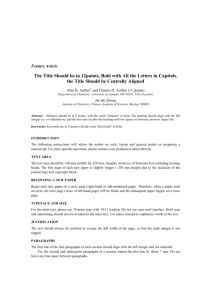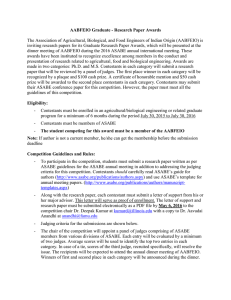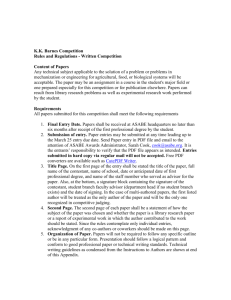Manuscript template
advertisement
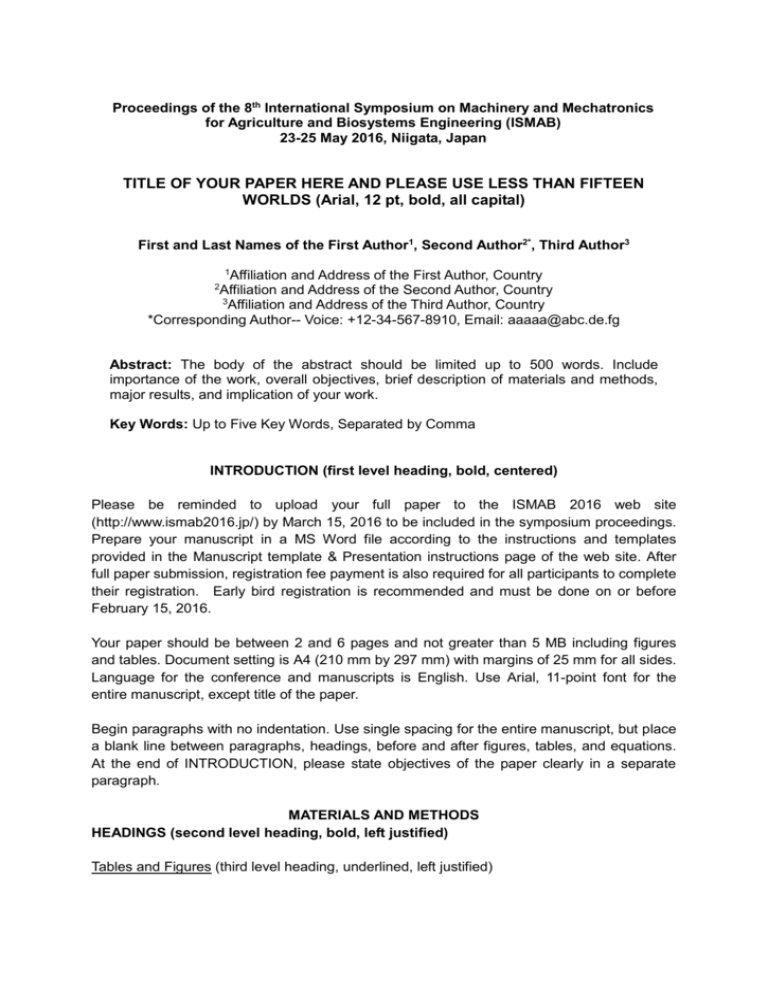
Proceedings of the 8th International Symposium on Machinery and Mechatronics for Agriculture and Biosystems Engineering (ISMAB) 23-25 May 2016, Niigata, Japan TITLE OF YOUR PAPER HERE AND PLEASE USE LESS THAN FIFTEEN WORLDS (Arial, 12 pt, bold, all capital) First and Last Names of the First Author1, Second Author2*, Third Author3 1 Affiliation and Address of the First Author, Country Affiliation and Address of the Second Author, Country 3 Affiliation and Address of the Third Author, Country *Corresponding Author-- Voice: +12-34-567-8910, Email: aaaaa@abc.de.fg 2 Abstract: The body of the abstract should be limited up to 500 words. Include importance of the work, overall objectives, brief description of materials and methods, major results, and implication of your work. Key Words: Up to Five Key Words, Separated by Comma INTRODUCTION (first level heading, bold, centered) Please be reminded to upload your full paper to the ISMAB 2016 web site (http://www.ismab2016.jp/) by March 15, 2016 to be included in the symposium proceedings. Prepare your manuscript in a MS Word file according to the instructions and templates provided in the Manuscript template & Presentation instructions page of the web site. After full paper submission, registration fee payment is also required for all participants to complete their registration. Early bird registration is recommended and must be done on or before February 15, 2016. Your paper should be between 2 and 6 pages and not greater than 5 MB including figures and tables. Document setting is A4 (210 mm by 297 mm) with margins of 25 mm for all sides. Language for the conference and manuscripts is English. Use Arial, 11-point font for the entire manuscript, except title of the paper. Begin paragraphs with no indentation. Use single spacing for the entire manuscript, but place a blank line between paragraphs, headings, before and after figures, tables, and equations. At the end of INTRODUCTION, please state objectives of the paper clearly in a separate paragraph. MATERIALS AND METHODS HEADINGS (second level heading, bold, left justified) Tables and Figures (third level heading, underlined, left justified) Place tables (refer as Table 1 in the text) and figures (refer as Fig. 1 in the text, but use Figure 1 at the beginning of paragraphs) after and close to their first reference in the text. When tables and figures are wider than the column, place them at the top or bottom of the page. Tables and their captions are left justified, but figures and their captions are centered. Use only black and white, or gray scale colors for figures. Table 1 Place caption above each table. Classification Velocity (m/s) Distance (m) Group A Group B 250 Stress (MPa) 200 150 100 50 0 0 0.02 0.04 0.06 0.08 0.1 Strain (%) Fig.1 Place caption below each figure. Equations, Symbols and Units Use MS Equation Editor to create equations (referred to as Eq. (1) in the text, but as Equation (1) at the beginning of paragraphs). Equations should be left aligned with an Arabic number placed within parentheses and right aligned. Following the equation, there should be an explanation of its components. (1) E where: = Strain (-) = Stress (GPa) E = Young's modulus (GPa) Follow internationally accepted rules and conventions: use the international system of units (SI). If other units are mentioned, please give their equivalent in SI RESULTS & DISCUSSION State your major findings and results along with the discussion. Try to discuss your results by relating to previous findings by others as well as to the objectives and problems mentioned in the INTRODUCTION section. Use figures and tables effectively along with sentences of statement. Do not omit mentioning important but rather unfavorable results. Any speculation or controversies should also be presented clearly and fairly. CONCLUSIONS Here, summarize your results and state any conclusions you draw from them as well as suggestions for future research work, if necessary. ACKNOLEDGEMENTS (optional) This section should be placed at the end of the paper before the REFERENCES section. This section includes acknowledgments of financial, institutional and personal support. REFERENCES Do not begin a new page for the section unless it is absolutely necessary. Each line of a reference, except the first one, should be indented 5 mm from the left margin. Please do not include submitted but not yet accepted papers. All references included in the list should be cited in the text and vice versa. In the text body, use the author-year system (e.g., Smith, 1989; Smith and Jones, 1989; Smith et al., 1989). When citing several references together, order them chronologically. In ‘references’ section, alphabetize the references according to the author’s last name and then chronologically. Listing references follow the rules used by the ASABE, available at http://www.asabe.org/media/59251/asabe_guide_for_authors.pdf. Examples are: Anderson, G. T., C. V. Renard, L. M. Strein, and E. C. Cayo. 1998. A new technique for rapid deployment of rollover protective structures. Applied Eng. in Agric. 23(2): 34-42. Coombs, T. R., and F. C. Watson. 1997. Computational Fluid Mechanics. 3rd ed. Wageningen, The Netherlands: Elsevier Science. Stratmeyer, H. A. 1965. Chapter 3: The goal of effective systems design. In Systems Design: Principles and Practices, 87-109. W. H. Pierre, ed. Chicago, Ill.: Graphics Publishing. CDC. 2000. Infection vectors for E. coli and intervention strategies. CDC Reference No. 9923. Atlanta, Ga.: Centers for Disease Control and Prevention. Cundiff, J. S., D.H. Vaughan, and D. J. Parrish. 1985. Pith separation procedure for processing whole-stalk sweet sorghum. In Proc. 5th Annual Solar and Biomass Workshop, 133-136. Ukiah, Cal.: Center for Solar Energy Research. Campbell, M. D. 1991. The lower limit of soil water potential for potato growth. PhD diss. Pullman, Wash.: Washington State University, Department of Agricultural Engineering. SAS. 1990. SAS User’s Guide: Statistics. Ver. 6a. Cary, N.C.: SAS Institute, Inc. NSC. 2001. Injury Facts Online. Itasca, Ill.: National Safety Council. Available at: www.nsc.org. Accessed 17 December 2001. APPENDIX (optional) or NOMENCLATURE (optional)
